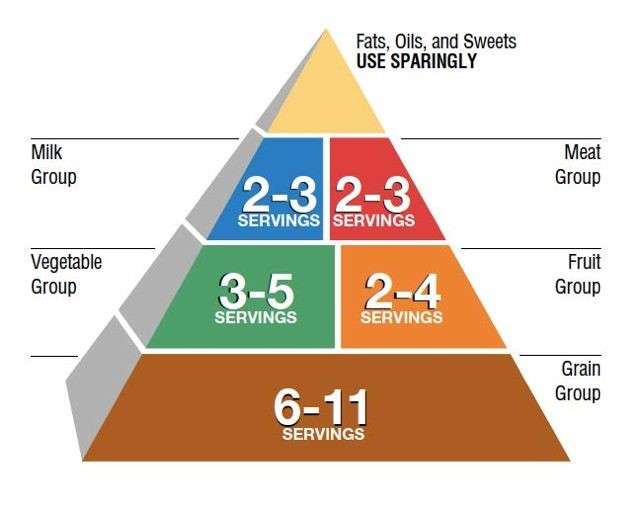Applying the food pyramid to Technology
Having effective technology conversations
One of the biggest challenges for any technology leader these days is communicating. How do you discuss the value you are driving? Scorecards, dashboards, performance management, talk like a CEO, and on and on. How do you sell a new idea or service? Start with the business perspective, link to tangible EBITDA improvement, learn from consumer products. Lots of questions. Lots of blogs. But the most basic communication challenge is much more fundamental. And that is this: How do you think about technology?
 You’re the CIO and we pay you something greater than nothing annually to think about technology. So, how do you … well, think about technology? After all, more and better technology — think AI or machine learning — signals the beginning of scaled automation, which some say could one day replace 1 in 2 jobs globally. So you should have a point of view and a way to structure your thinking that makes it easy for me, the layman CEO, to understand today’s tech as well as how you think about disruption. If they haven’t said this to you, they are thinking it.
You’re the CIO and we pay you something greater than nothing annually to think about technology. So, how do you … well, think about technology? After all, more and better technology — think AI or machine learning — signals the beginning of scaled automation, which some say could one day replace 1 in 2 jobs globally. So you should have a point of view and a way to structure your thinking that makes it easy for me, the layman CEO, to understand today’s tech as well as how you think about disruption. If they haven’t said this to you, they are thinking it.
Too often, technology leaders replace legitimate conversations about technology — and how to think about and strategize around it — with a lot of buzzwords and process jargon that doesn’t really help leadership conceptualize the present state and the future state. I’m going to try to explain how I look at technology at the macro level. For those of you that work with me, you may recognize this from a Tech Talk for our Americas business. Proof that I practice what I blog and vice versa.
Four Strategic Focus Areas
For at least the last 15 years, I have started with four principles. They have changed somewhat over time but in general I find these are easy to understand and apply to all sorts of businesses, including different service lines within my current business. My strategic priorities are simply to continue to deliver value through these four drivers:
- Utility – A strong foundation for future growth, with scalable and stable core services
- Productivity – Enabling efficient service delivery for all of our colleagues, regardless of role
- Connectivity – Enabling the power of our large global platform to effectively service local market needs
- Insight – Driving business growth through strategic use of information in analytics
I sometimes think of these four elements as components of a balanced technology portfolio, akin to a food pyramid, but for technological adoption.
For those of you who do not have children or work in schools, here is the food pyramid, the US government’s recommendation for balanced food “portfolios”:

Note: the new food pyramid is clearly the result of some consulting team getting paid loads to take something very simply and make it bizarrely complex so I will simply ignore that one.
It’s critical that CIOs and other technology leaders move beyond the buzzwords to try to structure their thinking. Executives are busy people. They’re constantly pulled in a thousand different directions. That’s why you see studies like this one from MIT’s Sloan School of Management: basically, 67 percent of senior leaders can’t name the priorities of their org. That’s bad on surface, yes, but it’s also pretty logical. Senior leadership is a constant battle between these three forces:
- What needs to get done
- What you want to get done
- What would be nice to do
That plays out in tech and tech adoption more than anywhere. That’s why you need some kind of rubric, concept, or way of thinking to escalate up the chain.
Back to my four areas.
Utility
 Utility is the base level — akin to breads, cereals, rice, and pastas. Here, you get the basics right. You build a strong foundation for future growth. The key in the utility stage — which is going to take you a bit of time; more on that in one second — is stable but also scalable core services. Runners know they need carbs to gain energy necessary to push their muscles and finish the race. Likewise, without the Utility level of technology (your “grains”), you cannot grow your business. The network may be boring, but it’s the only thing connecting each of your offices, factories, and teams.
Utility is the base level — akin to breads, cereals, rice, and pastas. Here, you get the basics right. You build a strong foundation for future growth. The key in the utility stage — which is going to take you a bit of time; more on that in one second — is stable but also scalable core services. Runners know they need carbs to gain energy necessary to push their muscles and finish the race. Likewise, without the Utility level of technology (your “grains”), you cannot grow your business. The network may be boring, but it’s the only thing connecting each of your offices, factories, and teams.
Here is something people often forget: You can INNOVATE within the utility layer. When I was a kid, most children ate plain old white bread. Now, they eat gluten free this, multi-grain that, and the bread aisle has dozens of choices. The basics have gotten better for you. Likewise, utility services must also continue to improve. We are moving to SD-WAN in our network space and away from traditional network architecture. We are using cloud storage solutions to replace file shares. Innovation at this level produces cost efficiencies and a stronger foundation. So, contrary to those who talk about “plumbing”, people or partners in this space are critical to your technology organization.
Productivity
 Productivity is how you begin building on utility. This means that, regardless of role, there needs to be effective service delivery. How do you build and improve tools that enhance our ability to execute our business? This is not just about collaboration tools, and is not the same as plumbing. This could include robots that automate cleaning bathrooms or presentation tools that generate dynamic reports with fewer hours required by graphic designers.
Productivity is how you begin building on utility. This means that, regardless of role, there needs to be effective service delivery. How do you build and improve tools that enhance our ability to execute our business? This is not just about collaboration tools, and is not the same as plumbing. This could include robots that automate cleaning bathrooms or presentation tools that generate dynamic reports with fewer hours required by graphic designers.
Manufacturing businesses constantly work on productivity and it is a major focus. But often professional services firms focus exclusively on “knowledge worker” productivity. In addition to the fact that I find that term completely offensive (maybe I’m too PC in thinking that implies other workers are not knowledgeable), it limits thinking. Productivity for Finance professionals can be generated by implementing cloud based, mobile friendly financial management and reporting tools like Workday. For a business development team, its effective client data management and presentations tools. For a janitor or engineer, it means service task management, or easy access to instructions for repeatable work.
And, yes, there is LOADS of innovation in this space. Get the pattern? You can innovate everywhere but you do need to think about the end goal. And in this layer of the “food pyramid”, you’ve got to get your fruits and veggies. You have to allow your people to better do their jobs.
Connectivity
 Connectivity is when you start moving to really grow the business through technology. “Milk: It does a body good” was the old slogan when I was a kid. It is great for growth, strong bones, and good teeth. Meat likewise gives you protein that helps build muscle mass. Likewise, connectivity is where you truly start to leverage technology to grow.
Connectivity is when you start moving to really grow the business through technology. “Milk: It does a body good” was the old slogan when I was a kid. It is great for growth, strong bones, and good teeth. Meat likewise gives you protein that helps build muscle mass. Likewise, connectivity is where you truly start to leverage technology to grow.
You have this large global business, but you want it to effectively meet local market needs. In the connectivity space we must make it easier for colleagues to share knowledge, find the right expert wherever they might be in the company, and create a richer experience with which you can connect with your clients. My blog is called Connections and the heart of this stage is connections. In my blog “Make Life Connections instead of networking”, I discuss the power of a network. Harnessing the intelligence and experience of the best people is critical for any business and in this stage we look for ways to more effective make these value driving connections.
Insight
 Finally, you get to insight. This is the “sweets and oils” section of my technological adoption pyramid. The difference in metaphor? Sweets and oils should be used sparingly, but … insight, which is all about driving business growth through advanced analytics, should be used consistently but ONLY once your business can arrive at this stage.
Finally, you get to insight. This is the “sweets and oils” section of my technological adoption pyramid. The difference in metaphor? Sweets and oils should be used sparingly, but … insight, which is all about driving business growth through advanced analytics, should be used consistently but ONLY once your business can arrive at this stage.
Dominic Barton, one of the global heads of McKinsey, has outlined something similar for the next 10-20 years of business. Analytics — using information as a competitive advantage — is still one of the cornerstones, but herein lies a problem.
Many companies try to jump all the way to the advanced analytics stage of this four-step model. They waste millions building massive “data lakes”, hiring data scientists, and celebrating “Big Data”. You absolutely cannot do that. Some businesses feel they can’t wait that long, but that’s a mistake. If you try to jump all the way to advanced analytics without the basics in place, a number of problems can result:
- You’re capturing the wrong intel
- You don’t have the right people to help analyze and present on it
- The data is duplicated or not scrubbed
- The pursuit of data is harming day-to-day technological needs
“Waiting patiently” is not a currency of most modern business, but in this case it’s all about moving through the steps in a logical way as opposed to rushing to where the revenue might be. When you try to hit the revenue stages too fast, many other functionalities can crumble around that pursuit. Like the food pyramid, if you eat too many sweets without your fruits, veggies, and grains, you may be fat and happy for a little while. But eventually, you are not healthy and begin to suffer.
Moving beyond the pyramid
Now, in the next post I do, I’m going to talk a little bit about disruption and how wrong a lot of us are in our thinking there. Disruption is very real — we get calls from dozens of startups every day trying to offer us services that we didn’t know we needed. But while disruption is real, our approaches to it (how to beat it back, embrace it, or drive it ourselves ) are hackneyed, old thinking. But that’s for the next post.
For now, I’m curious to hear: do you have ways that you think about technology and adoption cycles internally? I’m less about the cute acronyms and more about bringing along the most people possible to the mission and methodology. What say you?
Be well. Lead On.
Adam
Related Posts:
Investing in talent for the long-term
Peer accountability is critical to success in teams
Adam L. Stanley Connections Blog
Technology. Leadership. Food. Life.
Follow me on Twitter | Connect with me on Linked In | “Like” me on Facebook

